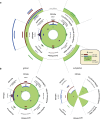Safe and just Earth system boundaries
- PMID: 37258676
- PMCID: PMC10322705
- DOI: 10.1038/s41586-023-06083-8
Safe and just Earth system boundaries
Abstract
The stability and resilience of the Earth system and human well-being are inseparably linked1-3, yet their interdependencies are generally under-recognized; consequently, they are often treated independently4,5. Here, we use modelling and literature assessment to quantify safe and just Earth system boundaries (ESBs) for climate, the biosphere, water and nutrient cycles, and aerosols at global and subglobal scales. We propose ESBs for maintaining the resilience and stability of the Earth system (safe ESBs) and minimizing exposure to significant harm to humans from Earth system change (a necessary but not sufficient condition for justice)4. The stricter of the safe or just boundaries sets the integrated safe and just ESB. Our findings show that justice considerations constrain the integrated ESBs more than safety considerations for climate and atmospheric aerosol loading. Seven of eight globally quantified safe and just ESBs and at least two regional safe and just ESBs in over half of global land area are already exceeded. We propose that our assessment provides a quantitative foundation for safeguarding the global commons for all people now and into the future.
© 2023. The Author(s).
Conflict of interest statement
The authors declare no competing interests.
Figures




Comment in
-
How to define unjust planetary change.Nature. 2023 Jul;619(7968):35-36. doi: 10.1038/d41586-023-01743-1. Nature. 2023. PMID: 37258728 No abstract available.
-
Concerns regarding proposed groundwater Earth system boundary.Nature. 2024 Nov;635(8039):E4-E5. doi: 10.1038/s41586-024-08082-9. Epub 2024 Nov 20. Nature. 2024. PMID: 39567796 Free PMC article. No abstract available.
References
-
- IPBES. Global assessment report on biodiversity and ecosystem services of the Intergovernmental Science-Policy Platform on Biodiversity and Ecosystem Services. Zenodo10.5281/zenodo.5657041 (2019).
-
- IPCC Climate Change 2022: Impacts, Adaptation, and Vulnerability (eds Pörtner, H.-O. et al.) (Cambridge Univ. Press, 2022).
-
- Rockström, J. et al. Identifying a safe and just corridor for people and the planet. Earth’s Future9, e2020EF001866 (2021).
-
- Rockström, J. et al. Stockholm to Stockholm: achieving a safe Earth requires goals that incorporate a just approach. One Earth4, 1209–1211 (2021).
Publication types
MeSH terms
Substances
LinkOut - more resources
Full Text Sources
Medical

